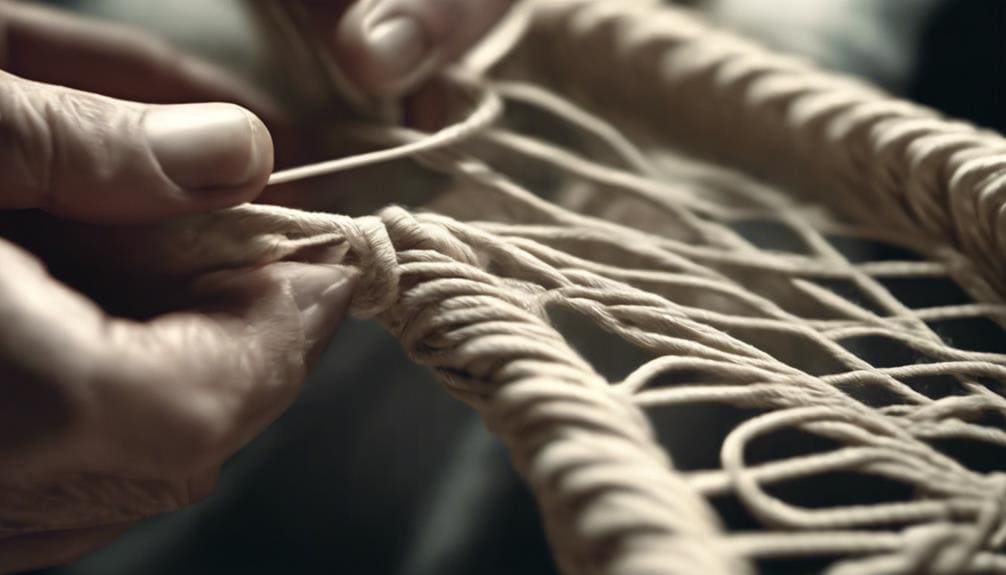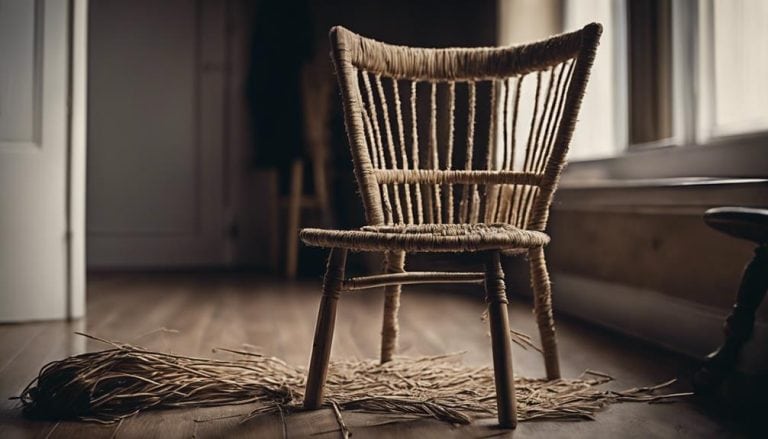Danish Cord Crafting Techniques
In Danish Cord Crafting Techniques, intricacy meets tradition in a dance of durability and elegance. The art of weaving paper cord around a wooden frame might sound simple, but the devil is in the details.
From mastering classic patterns to understanding the nuances of tension and spacing, Danish Cord Crafting is a craft that beckons those who appreciate the blend of form and function. But what sets this technique apart from the rest? Let’s explore the secrets that make Danish Cord Crafting a timeless art form with modern applications.
Danish cord crafting techniques involve weaving paper cords around a frame to create durable and stylish furniture. This traditional method requires precision and patience, resulting in beautiful and long-lasting pieces.
Key Takeaways
- Danish cord weaving requires meticulous skill and precision for functional yet artistic furniture pieces.
- Essential materials and tools like twisted paper cord and wood block are crucial for crafting.
- Step-by-step instructions include securing the cord, maintaining spacing, and tacking for a sturdy finish.
- Master Danish cord techniques by understanding knots and precise measurements and incorporating double rails for intricate patterns.
History of Danish Cord Weaving
Originating in the early 20th century in Denmark, Danish Cord Weaving emerged as a hallmark of Scandinavian design innovation. The Danish furniture designers of that era revolutionized the concept of seating by intricately weaving twisted kraft paper around wooden frames to create sturdy yet visually appealing chairs.
This weaving technique provided a strong foundation for the seats and added a touch of elegance to the furniture pieces. Techniques such as basketweave and herringbone were employed to craft intricate patterns that set Danish Cord Weaving apart from conventional methods.
The history of Danish Cord Weaving is a testament to the meticulous skill and precision required in furniture making. Each strand of cord had to be evenly spaced and woven with expertise to ensure durability and longevity. The resulting chairs weren’t just functional pieces but also works of art that reflected the craftsmanship and attention to detail of the Scandinavian designers of that time.
Materials Needed for Danish Cord Crafting

Continuing from the history of Danish Cord Weaving, the fundamental materials required for Danish cord crafting are essential to uphold the authentic craftsmanship and intricate designs of this traditional technique. Danish cord crafting necessitates twisted treated paper cord, typically around 1/8 inch in diameter, known as Danish Paper.
Approximately 2 pounds of rope cord are essential for each chair undergoing Danish cord weaving. The essential tools for this craft include a hammer, knife or scissors, woodblock, and the required rope cord. When re-weaving chairs, attention to the original details is crucial to maintaining the authentic weave pattern. The front rail weaving is a critical part of Danish cord crafting, supporting the seat.
It’s vital that the weaving be tight but not excessively so, ensuring durability and comfort. Mastering the process of weaving warp cords through the double rails is key to achieving the intricate and sturdy chair seats synonymous with Danish cord weaving techniques.
Step-by-Step Danish Cord Weaving Instructions

Beginning the intricate process of Danish cord weaving, the first step involves securing the Danish cord to the frame and weaving it tightly around the front rail to provide essential support.
- Achieve Precision: Ensure each weave around the front rail is snug by maintaining the original spacing using a wood block for a professional finish.
- Cosmetic Perfection: Tack the cord to cover the exposed areas on the back rail, wrapping it with a similar spacing pattern to elevate the chair’s aesthetics.
- Side-to-Side Mastery: Weave the cord over and under the front rail weave for side-to-side weaving on the upper and lower side rails, ensuring a consistent and secure pattern.
- Finishing Touch: Complete the side-to-side weave by securely tacking the ends on the inside side rail, trimming any excess rope for a sleek and polished final look.
Crafting Danish cord seats involves a delicate balance of technique and artistry, ensuring structural integrity and exquisite chair designs that stand the test of time.
Tips for Mastering Danish Cord Techniques

As I hone my Danish cord weaving skills, mastering the intricate techniques involves understanding the cow-hitch knot for securing warp cords and ensuring precise measurements for consistent weaving patterns. The cow-hitch knot is the backbone of Danish cord weaving, providing a secure foundation for the woven seats of Danish design furniture. Mastering this knot can achieve strength and a refined seat-weaving aesthetic.
When marking centerlines and distances for warp cords, accuracy is paramount. These markings guide the creation of flawless patterns in the woven cords, showcasing the beauty of Danish design craftsmanship. Creating templates for chair sets’ centerline layout marks can streamline weaving, ensuring each piece is meticulously crafted.
Incorporating double rails in Danish cord weaving allows for intricate cord reversals without additional hardware, showcasing the elegance of unlaced cord techniques. Skillfully weaving side-to-side patterns over front rail weaves demands attention to detail and precise spacing for a flawless finish that embodies the essence of Danish cord craftsmanship.
Maintenance and Care for Danish Cord Furniture

To maintain the beauty and longevity of your Danish cord furniture, regular dusting and gentle cleaning with mild soap are essential practices. The delicate nature of the paper cord used in crafting these pieces requires special attention to ensure they remain in pristine condition.
Here are some powerful maintenance tips for your Danish cord furniture:
- Avoid Direct Sunlight: Shield your Danish cord furniture from direct sunlight exposure to prevent the paper cord from fading and weakening over time.
- Gentle Cleaning Techniques: Use a soft brush or cloth to dust regularly, and for deeper cleaning, gently wipe the cord with mild soap and water, ensuring not to oversaturate.
- Inspect for Damage: Regularly check the cord seat for any signs of wear, loose cow hitches, or unraveling warp pairs, addressing these issues promptly to prevent further damage.
- Protective Measures: Consider applying a thin coat of varnish or wax to the cord surface to enhance its durability and longevity while maintaining the aesthetic appeal of basket weaving.
Incorporating Danish Cord in Home Decor

Incorporating Danish cord weaving into home decor opens up a world of elegant possibilities, transforming living spaces with its timeless charm and intricate craftsmanship. The iconic designs of Hans Wegner, such as the Wishbone Chair, often showcase Danish cord intricately woven around the frames, creating a blend of functionality and artistry.
Consider pairing Danish cord furniture with minimalist artwork and organic textures to enhance the Scandinavian aesthetic. Additionally, incorporating Wegner-inspired lighting fixtures and sticking to a Scandinavian color palette can further accentuate the beauty of Danish cord weaving in your home.
Using nails to fasten the cord around the furniture frames is recommended for a secure and lasting installation. By combining functional accessories with Danish cord furniture, you can achieve a cohesive and stylish interior design that exudes sophistication and power. Embrace the heritage of Danish cord weaving to elevate your home decor with a touch of mid-century modern flair.
Frequently Asked Questions
What Are the Different Types of Danish Cord Weaving?
In Danish cord weaving, various techniques like twisted patterns, color variations, and tension control create distinct designs. Decorative knots and finishing touches enhance the aesthetic appeal, while advanced techniques allow for intricate customization and durability in furniture crafting.
What Is the Nail Spacing for Danish Cord Weaving?
Nail spacing in Danish cord weaving is crucial for maintaining even tension and stability. Consistent spacing ensures a uniform weave pattern, strength, and durability. Follow guidelines for successful weaving, creating aesthetically pleasing and sturdy seats.
How Do You Make a Danish Paper Cord?
Creating a Danish paper cord involves intricate cord-twisting techniques to enhance its strength. Weaving patterns offer endless variations, demanding precise cord tension adjustments. The chair seat’s durability relies on mastering cord finishing methods for lasting craftsmanship.
What’s the Difference Between Laced and Unlaced Danish Cord?
The difference between laced and unlaced Danish cord lies in the intricate twist pattern of laced cord versus the simpler, straight appearance of unlaced cord. Laced adds design flair, while unlaced focuses on functionality.
Conclusion
In conclusion, mastering Danish cord crafting requires patience, precision, and a keen eye for detail. Remember, ‘practice makes perfect’ when it comes to creating intricate patterns and sturdy furniture pieces. With dedication and practice, you can truly elevate your skills and create timeless pieces that will stand the test of time. So, keep weaving, keep creating, and let the beauty of Danish cord shine in your home decor.







